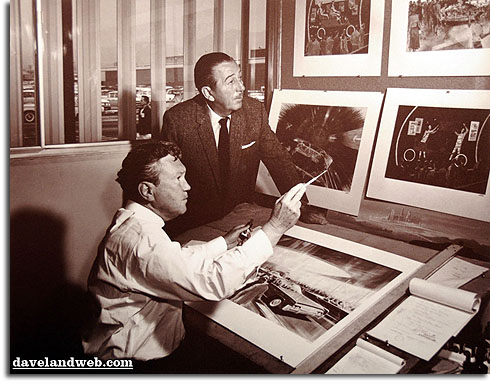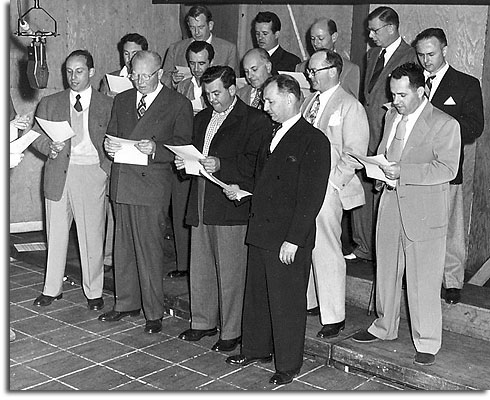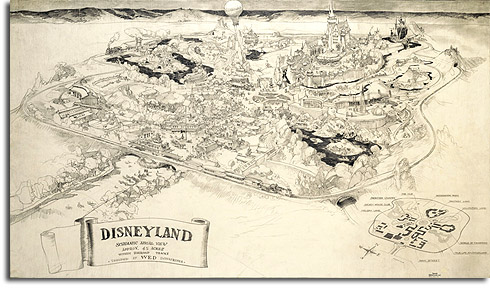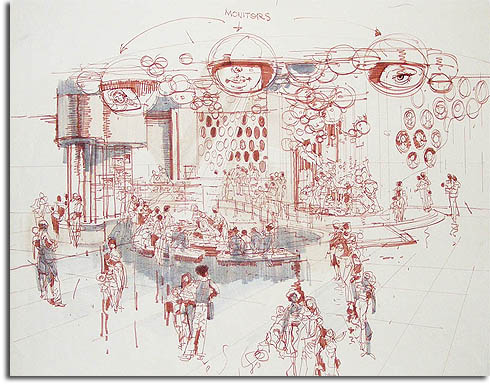Seeing as we’ve dedicated this month to Disney artist Herbert Ryman on the occasion of what would have been his 100th birthday, it’s only appropriate that we review at last a book about Mr. Ryman that came out earlier this year. Warp and Weft: Life Canvas of Herbert Ryman is far from a conventional biography or history; in fact, author John S. Donaldson bills it as a memoir/biography. Donaldson spent three decades as a friend and apprentice of Ryman’s, and practically grew up in his household. While this obviously brings a certain lack of objectivity to the proceedings, Donaldson’s unique situation lends a perspective that any other biographer would necessarily lack. Is it the definitive last word on Ryman’s artwork and career? No. But it’s a fascinating look at one of Disney’s most important artists and the most in-depth work that I’m aware of about any of the Imagineers.
 Herb Ryman and Walt Disney. Ryman is working on conceptual artwork for the Magic Skyway attraction from the 1964/65 New York World’s Fair. (Photo: Daveland)
Herb Ryman and Walt Disney. Ryman is working on conceptual artwork for the Magic Skyway attraction from the 1964/65 New York World’s Fair. (Photo: Daveland)Herb Ryman occupies a fairly unique place in Disney history. He’s a member of that generation of artists at the Disney animation studio that would go on to found Walt Disney Imagineering (then known as WED Enterprises). But Ryman had a successful career before his time at Disney; he was well-established both as an independent artist and as a member of the art department at Metro-Goldwyn-Mayer. In fact, he came within a hair’s breadth of being the art director for Gone With The Wind in 1939.
 This photograph of the 20th Century Fox art department shows several individuals that would soon prove crucial to the development of Disneyland, and later Walt Disney World. On the back row you can find Richard Irvine (3rd from left) and Marvin Davis (5th from left). On the second row, far left, is Ryman, and beside him is George Patrick.
This photograph of the 20th Century Fox art department shows several individuals that would soon prove crucial to the development of Disneyland, and later Walt Disney World. On the back row you can find Richard Irvine (3rd from left) and Marvin Davis (5th from left). On the second row, far left, is Ryman, and beside him is George Patrick.Over the years Ryman would come and go at will, leaving Disney when things got dull to take projects he found more interesting in other venues. His time at 20th Century Fox proved especially fruitful, as it was there that he would meet several key members of the art staff that would later be brought back to WED to help design Disneyland.
Disney fans well know Ryman’s contributions in this field – not only did he create that legendary first rendering of Disneyland in 1953, but also the first painting of Cinderella Castle for Walt Disney World and a number of other historic pieces. In fact, he was working on new Disney park projects up until the time of his death in 1989.
 Ryman’s famous first rendering of Disneyland from 1953. Ironically, Ryman himself was embarrassed by this image, created as it was in merely two days, yet it’s gone on to fire the imaginations of generations of fans.
Ryman’s famous first rendering of Disneyland from 1953. Ironically, Ryman himself was embarrassed by this image, created as it was in merely two days, yet it’s gone on to fire the imaginations of generations of fans.But Warp and Weft isn’t necessarily the tale of Ryman’s work. Instead, it’s the story of his life and how it intersected and overlapped with a number of other notable characters, and the grand web of coincidence and happenstance reflected in the lives of people who live in interesting times. The books title is entirely apropos; at times it’s not really Herb’s story at all, but rather a snapshot of the entire fabric of his existence and the others that attached themselves to it.
The main thread of the fabric is, naturally, Ryman himself. Aside from that, though, a great amount of time is given to the tale of Walt Disney; his early life in the Midwest came remarkably close at times to Ryman’s own upbringing. In fact, Ryman’s mother, in an attempt to improve their situation, associated herself with a group of investors in the O-Zell jelly company – the very same O-Zell company whose collapse took with it the savings of Walt’s dad, Elias.
There are many coincidences like these as Herb and Walt live out their childhoods in the Midwest; as Walt heads to Kansas City and then Hollywood, Herb tries to make it as an artist despite the constant discouragements of his mother. Some of the details Donaldson turns up about Walt’s life in Kansas City are fascinating and there are several stories I’ve never heard elsewhere; Donaldson is good at digging to the root of the story and finding the odd connections that make these yarns truly interesting in an “ah-ha!” sort of way. Often you’ll find yourself following the doings of people you’ve never heard of, until its finally revealed how they fit into the tale – one expects Paul Harvey to chime in with “that’s the rest of the story!”
Ryman’s life is a series of fascinating connections itself; a trip around the world to paint put him in the path of oncoming war, and so we have brushes with many fascinating characters in Siam and China. Even the Peking Man himself makes an appearance! There are movie stars known and obscure; Howard Hughes makes an appearance as does, much later, Marilyn Monroe. Quite a tapestry, indeed.
Warp and Weft has caused some sturm and drang in the Disney historical community, mostly concerning Donaldson’s portrayal of Ryman’s sister Lucille and her husband, actor John Carroll. The portrayal is indeed unkind; Ryman and Carroll come off as a combination of Bonnie and Clyde and Laurel and Hardy – she’s a shallow, grasping type, always on the take and on the make. Carroll is a suave, aging film actor, who also seems to always be on the lookout for a fresh mark and willing to do anything for a buck. The two of them con and scam their way through the years, defrauding and bilking seemingly everyone they come across, while working hard to portray a veneer of respectability and taking everything they can from Herb. The picture, as painted, is not pretty.
After Herb’s death, Lucille spent most of her time promoting their legacy through the Ryman-Carroll Foundation, and in the process it’s not surprising that she seems to have made quite a positive impression on many of those in the Disney community. Thus, many have reacted strongly in the negative against Donaldson’s book, claiming positive personal experiences with Lucille or having heard positive things from others. Some have charged bias; Donaldson claims in the book that Lucille denied him his inheritance from Herb (that inheritance being Herb’s paintings and artwork) and it’s clear those wounds go deep. That certainly can’t be discounted, but Donaldson has been careful to provide documentation for many of his claims and that makes them difficult to dismiss out-of-hand. Add to that the predilection that Lucille and John Carroll had for audiotaping everything, from phone calls to conversations, and the evidence becomes far less circumstantial – especially considering that Donaldson has made some of the most pertinent recordings available on his website. After my own heart, there’s a 41-page list of citations in the back of the book pointing to primary sources for further reading and research; there’s also a wonderfully detailed index, which is a pleasant rarity.
It’s up to the reader to make up their own mind on these controversial issues, based on the facts given them. For my part, it’s hard to imagine an author forging such copious amounts of documentary evidence for the sake of some post-mortem one-upsmanship. The author certainly doesn’t try to hide his feelings and opinions, so I would encourage the individual reader to assess the well-cited sources and judge the more personal passages for themselves. Regardless of any disputed historical content, I found the segments of the book documenting Ryman and Carroll’s shenanigans at the very least to be an entertaining yarn.
It’s impossible to discuss this book without mentioning the style in which it is written. Donaldson writes in a very stylized fashion; it’s a very lyrical style with lots of alliteration, rhyme, and wordplay. The prose is very punchy and at times staccato, and there is the occasional overuse of commas. At times it reads like beat poetry, or even hip-hop lyrics, and at other times it consists of rhymed couplets, almost like a limerick. It takes getting used to, I found, and can be jarring at first; after you get in the “mindset,” though, it becomes less noticeable and part of the experience. Unfortunately the wordplay can sometimes get in the way of the narrative, obfuscating meaning and drawing the reader’s attention from substance to style. Stylized prose can be effective in describing a bucolic Midwestern childhood, for instance, but just tends to get in the way of the narrative when the action picks up or when the author is trying to convey complicated issues or nuanced interactions.
The resulting effect of this style is fairly affable, though, and the presence of the narrator as a distinct voice makes sense when the story is being told by a participant. While some of the wordplay and punnery at times reminds one of the pleasant yet corny uncle lobbing zingers at the dinner table, there were plenty of times that I laughed out loud at the narration’s commentary. It’s definitely an unusual style, but it’s also unique, at times lyrical, and it works most of the time.
As stated, there’s some debate amongst Disney historians about some of the opinions expressed in this book. Fans might blanch at less-than-flattering portrayals of a number of Disney icons, especially John Hench, Marty Sklar, and Harrison “Buzz” Price. Indeed these criticisms are deeply personal and often scathing. It can make for conflicting feelings and it’s certainly not unbiased, but even for skeptics I think the book as a whole contains enough fascinating stories of Ryman’s life and Walt’s own history to justify itself. You might disagree with the more contentious parts of the narrative or not, but the fact remains that the majority of the book devoted to Herb’s life, work, and friendship with Walt demands attention. For those with an open mind about the more controversial aspects, it’s an interesting read. At the very least, it’s a much-needed tribute to a great artist and it keeps the name of Herbert Ryman alive while fleshing out his life for a generation of fans.
Could this book have been more? I think so. I could definitely have used more discussion of Ryman’s work, from both technical and historical standpoints, and more detail about the projects on which he worked. There’s also a certain anecdotal element that’s missing; those bits and bobs of stories from daily life that would be invaluable in understanding the man, especially considering that the author spent so much time observing Ryman firsthand. But the desire to know more doesn’t mean that what’s already in the book isn’t illuminating itself, and so Warp and Weft: Life Canvas of Herbert Ryman should be on the reading list for anyone interested in the Disney titans of old. Herb’s work – and long career – certainly deserve the attention.
Warp and Weft: Life Canvas of Herbert Ryman – 400 pages, softcover. Published by Incanio, Ltd. $19.95, available from their website.











Well written review and could not have been more objectively stated. I was there for some of the experiences and stories retold and they are as Herb told them to me. So I believe that Donaldson wrote what he saw and heard and added a dose of his own emotion.